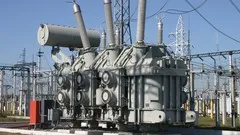
Power Engineering: Power System Analysis - Part 3 
This course is the third part of a multi-part series on power system analysis, a crucial area of electrical engineering. By learning about power flow analysis and short circuit analysis, you will gain the essential knowledge needed for a successful career in power engineering. Get a comprehesive understanding of this course which is a cost course. AZ Class provides this course data for free. Learn more certificate and details here. ▼
ADVERTISEMENT
Course Feature
![]() Cost:
Cost:
Paid
![]() Provider:
Provider:
Udemy
![]() Certificate:
Certificate:
Paid Certification
![]() Language:
Language:
English
![]() Start Date:
Start Date:
2023-04-01
Course Overview
❗The content presented here is sourced directly from Udemy platform. For comprehensive course details, including enrollment information, simply click on the 'Go to class' link on our website.
Updated in [October 18th, 2023]
What does this course tell? (Please note that the following overview content is from the original platform) This course is the third part of a multi-part course series about one of the main areas of electrical engineering: power system analysis Power system analysis is the core of power engineering and its understanding is therefore essential for a career in this field In this third course of the multi-part course series you will learn about power flow (load flow) analysis and short circuit analysis and their use in power systems The course is divided into the following sections:1 Power Flow (Load Flow) Analysis: in section 2 we will introduce the concept of power flow Also referred to as load flow power flow is the analysis of how apparent real and reactive power flows between parts of a power system from generation to the loads One of the most widely used methods of Power Flow analysis will be covered: the Gauss-Seidel method method A full example will be solved to help explain how this method is used for power flow analysis2 Short Circuit Analysis of Balanced Faults: in section 3 we will introduce short circuits Also referred to as faults short circuits are undesired occurrences in power systems when conductors are shorted between each other to ground or a combination of these This is the basis for the field of power system protection and control which is widely important for the safe and reliable operation of power systems To introduce how short circuits (faults) affect power systems we will begin by discussing balanced (ie three-phase) short circuits We will also introduce the concept of the short circuit capacity and the bus impedance matrix3 Short Circuit Analysis of Unbalanced Faults: in section 4 we will continue discussing short circuits (faults) but will discuss the more complex analysis of unbalanced faults (eg single-line-to-ground line-to-line and line-to-line-to-ground faults) To do this we will introduce the technique of symmetrical components which allows us to analyze unbalanced power systems more easily This will allow you to further your career in power system protection and protective relayingIn each section several examples are solved to illustrate how to analyze real-world power systemsBy learning about power flow analysis and short circuit analysis and how they are used in power systems you will be able to continue your study of power system analysis for a career in power engineering and electrical engineering Remember that Udemy offers a 30-day money-back guarantee I am also always available for questions while you go through the course to ensure everything is clearSee you in the course! We considered the value of this course from many aspects, and finally summarized it for you from two aspects: skills and knowledge, and the people who benefit from it: (Please note that our content is optimized through artificial intelligence tools and carefully reviewed by our editorial staff.) What skills and knowledge will you acquire during this course? During this course, the learner will acquire the following skills and knowledge: 1. Power Flow (Load Flow) Analysis: The learner will understand the concept of power flow and its importance in power systems. They will learn about the analysis of apparent, real, and reactive power flow between different parts of a power system, from generation to loads. The course will cover the Gauss-Seidel method, which is a widely used method for power flow analysis. A full example will be solved to demonstrate the application of this method. 2. Short Circuit Analysis of Balanced Faults: The learner will be introduced to short circuits, which are undesired occurrences in power systems when conductors are shorted between each other or to ground. They will understand the significance of short circuit analysis in power system protection and control. The course will focus on balanced (three-phase) short circuits and discuss the concept of short circuit capacity and the bus impedance matrix. 3. Short Circuit Analysis of Unbalanced Faults: The learner will delve into the analysis of more complex unbalanced faults, such as single-line-to-ground, line-to-line, and line-to-line-to-ground faults. They will be introduced to the technique of symmetrical components, which simplifies the analysis of unbalanced power systems. This knowledge will be valuable for a career in power system protection and protective relaying. Throughout the course, several real-world examples will be solved to illustrate the application of power flow analysis and short circuit analysis in power systems. By acquiring these skills and knowledge, the learner will be equipped to pursue a career in power engineering and electrical engineering. Additionally, the instructor offers a 30-day money-back guarantee and is available for any questions or clarifications during the course. Who will benefit from this course? This course on Power Engineering: Power System Analysis - Part 3 will benefit individuals interested in pursuing a career in power engineering and electrical engineering. Specifically, it will be beneficial for: 1. Power Engineers: Power system analysis is the core of power engineering, and this course provides a deep understanding of power flow analysis and short circuit analysis. Power engineers will gain the necessary knowledge and skills to analyze and design power systems, ensuring their safe and reliable operation. 2. Electrical Engineers: Power system analysis is a fundamental aspect of electrical engineering. This course will enhance the understanding of power flow and short circuit analysis, enabling electrical engineers to effectively design and troubleshoot power systems. 3. Power System Protection and Control Professionals: Short circuit analysis is crucial for power system protection and control. This course covers both balanced and unbalanced faults, providing professionals in this field with the necessary tools to ensure the safety and reliability of power systems. 4. Students and Researchers: This course serves as a comprehensive resource for students and researchers interested in power system analysis. It covers advanced topics such as symmetrical components, allowing individuals to delve deeper into the field and contribute to the advancement of power engineering. By completing this course, individuals will be equipped with the knowledge and skills required to pursue a successful career in power engineering and electrical engineering.
Course Syllabus
Course Introduction
Power Flow (Load Flow) Analysis in Power Systems
Short Circuit Analysis of Balanced Faults in Power Systems
Short Circuit Analysis of Unbalanced Faults in Power Systems
Bonus Section
Course Provider

Provider Udemy's Stats at AZClass
Discussion and Reviews
0.0 (Based on 0 reviews)
Explore Similar Online Courses

Electrical Power Grid Modernization: Smart Grid Concepts

Power Engineering: Power System Analysis - Part 2

Python for Informatics: Exploring Information

Social Network Analysis

Introduction to Systematic Review and Meta-Analysis

The Analytics Edge

DCO042 - Python For Informatics

Causal Diagrams: Draw Your Assumptions Before Your Conclusions

Whole genome sequencing of bacterial genomes - tools and applications

Systems Innovation

power system analysis by Etap


Start your review of Power Engineering: Power System Analysis - Part 3